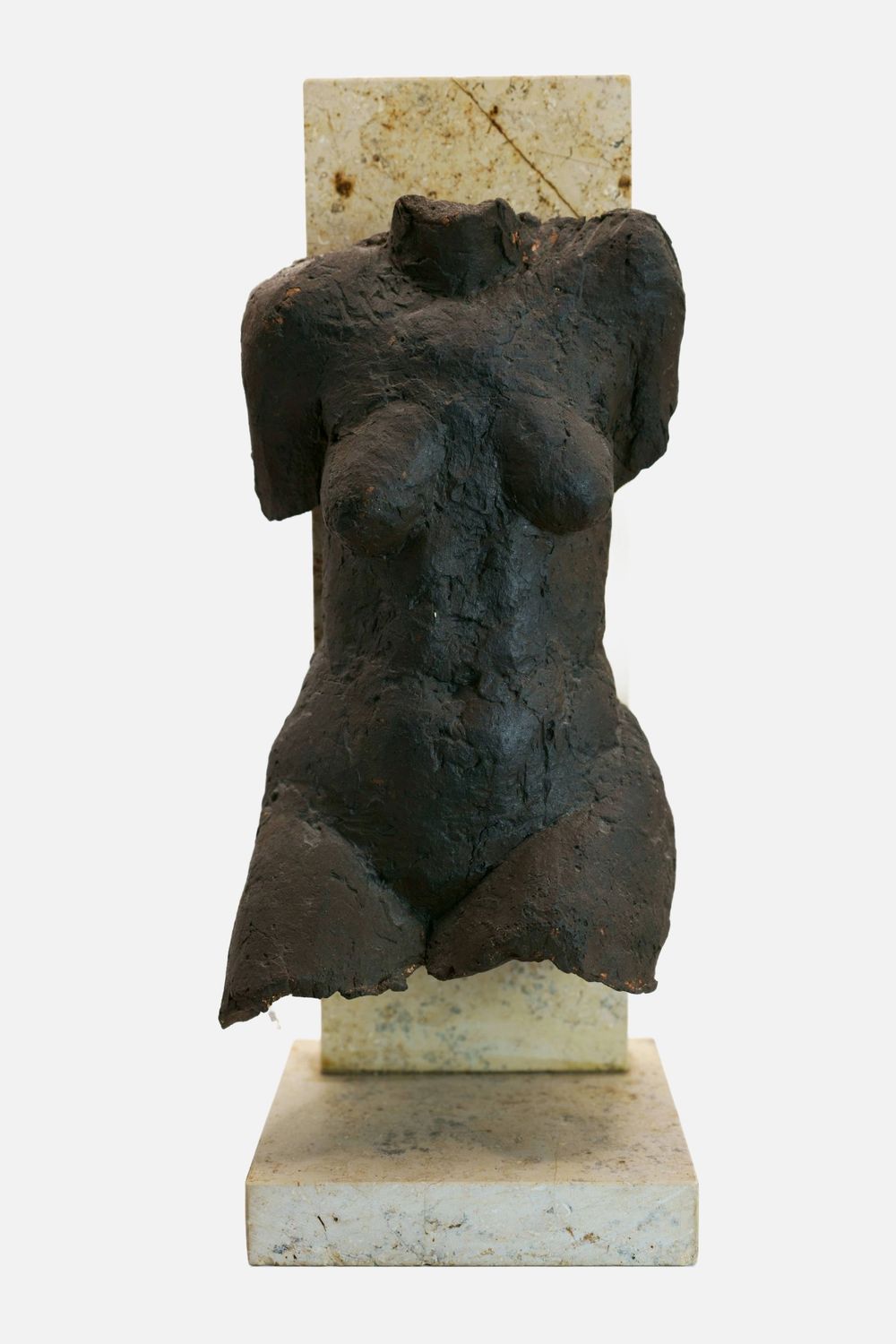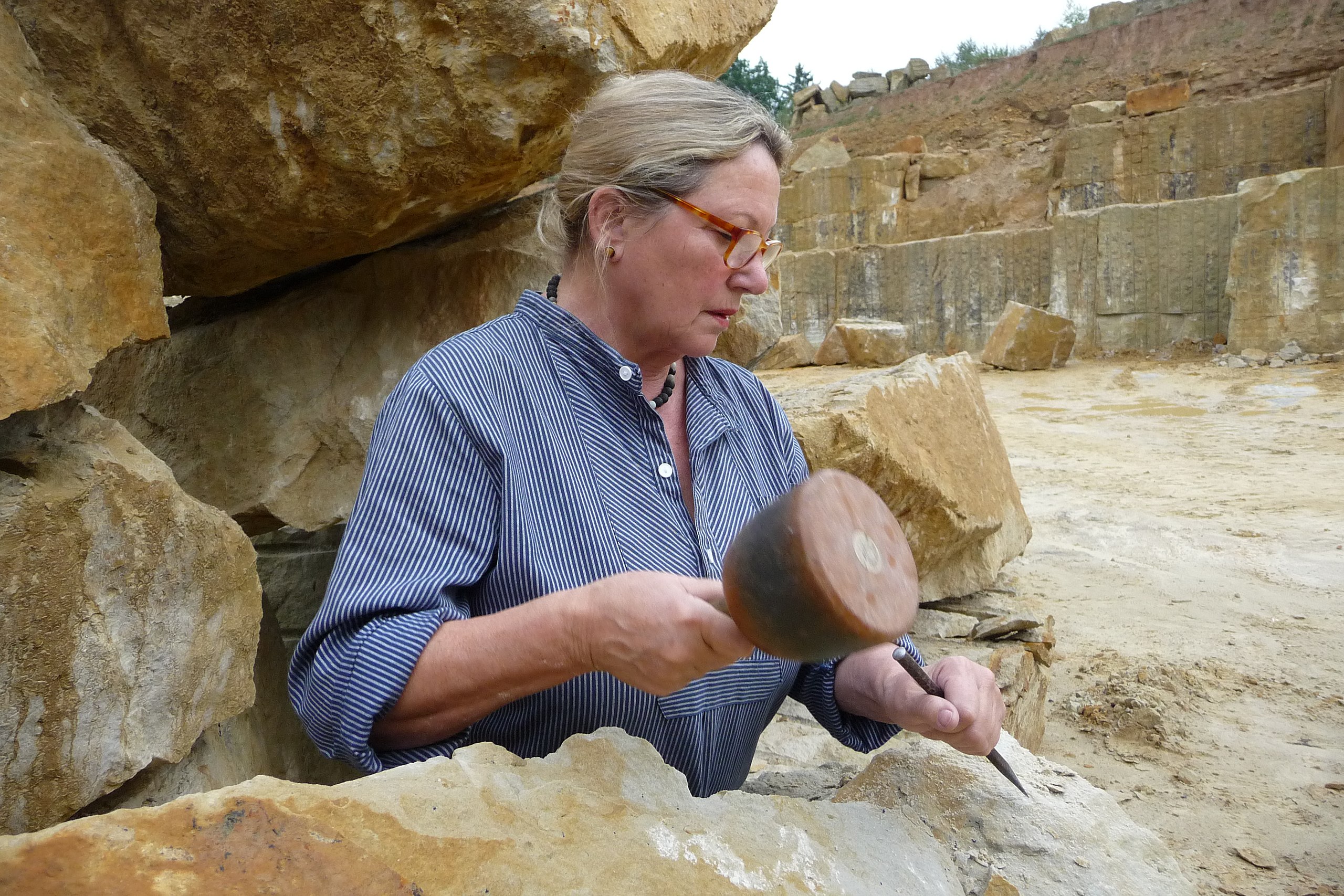Dewerny, Christine (*1947), Female Torso, c. 1986
Christine Dewerny(*1947 Leipzig), Female Torso, c. 1986, dark colored clay mounted on a light stone stele, 19 x 10 x 7 cm (depiction), 27 x 10 x 10 cm (stele), monogrammed "CHD" on the right thigh, the underside of the base inscribed by hand as "weibl. Torso" and signed "Dewerny".
- Stele with bumped corner and glued crack.
Exposé as PDF
- Primal Femininity -
The "Female Torso", created around 1986, can be seen as the beginning of Christine Dewerny's actual artistic work, as she had given up her engagement as a theater sculptor that year in order to devote herself entirely to sculpture. This gives the work a programmatic character, which is also reflected in the fact that the torso was cast in bronze in 1987. The bronze-like patina of the terracotta suggests that the torso was conceived from the outset to be realized in bronze, although it is also a unique work of art in its own right.
Mounted on a light-colored stone stele that matches the dark patina of the figure, the torso is emphasized as a surviving fragment, which, placed in a state of suspension, also presents itself as a complete work of art. The fragmentary aspect gives the sculpture an archaic quality. Against the background of a symmetrically stylized originality, however, the torso appears extremely lively, which is brought about by the clear asymmetrical moments: The shoulders, the breasts and the legs break the uniformity imposed by the frontal view and set the torso in motion, giving the impression that it is moving as we walk around it.
The effect of liveliness is enhanced by the intentional firing cracks. They give the torso a visual vibrato. At the same time, they look like traces of age, which corresponds to the fragmentary nature of the figure and emphasizes the archaic character. This originality elevates the torso to something archetypal, which, pars pro toto, stands for femininity as such. For this reason, three years after the Female Torso, in 1990, Dewery created a 'Male Torso' as a counterpart. Seen as a symbol of the female body, the burn marks look like scars that mark the body with the suffering it has endured since its expulsion from paradise. At the same time, however, the marks are also traces of modeling that keep the formal force present in the form, which in turn increases the effect of liveliness, even though it is a torso. This paradox between fragmentary relic and living creation gives the sculpture its intense aura.
About the artist
Christine Dewerny by Raimund Dewerny /
CC BY-SA 4.0
As the daughter of a props master in Leipzig, Christine Dewerny was already interested in the visual world of the theater. Parallel to her training as a stage designer at the Deutsche Staatsoper, she studied at the Hochschule für Angewandte Kunst in Berlin and then, from 1965 to 1968, theater sculpture at the Hochschule für Bildende Künste in Dresden with Walter Arnold and Otto Thielike. This led to her work at the Berlin Volksbühne and Komische Oper, where she worked with directors such as Walter Felsenstein, Götz Friedrich and Harry Kupfer until 1986.
From 1986, Dewery devoted herself entirely to sculpture. In 1987 she was accepted into the Association of Visual Artists of the GDR and later became a member of the Professional Association of Visual Artists in Berlin. In 1994 she initiated the GEDOK Group Brandenburg, part of the most important association of women artists founded in 1926.
Christine Dewerny's work has been shown in numerous solo exhibitions. Her portrait busts, such as Siegfried Matthus (2007, Rheinsberg), Götz Friedrich (2008, Berlin), Hanns Eisler (2010, Berlin), Käthe Kollwitz (2013, Berlin), the Mask of Medea as a tribute to Christa Wolf (2016, Berlin) and Helmut Kohl (2018, Berlin), are particularly present in public spaces.


